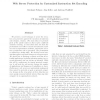Free Online Productivity Tools
i2Speak
i2Symbol
i2OCR
iTex2Img
iWeb2Print
iWeb2Shot
i2Type
iPdf2Split
iPdf2Merge
i2Bopomofo
i2Arabic
i2Style
i2Image
i2PDF
iLatex2Rtf
Sci2ools
IPPS
2006
IEEE
2006
IEEE
Web server protection by customized instruction set encoding
We present a novel technique to secure the execution of a processor against the execution of malicious code (trojans, viruses). The main idea is to permute parts of the opcode values so that it gets a different semantic meaning. A virus which does not know the permutation is not able to execute and will cause a failure such as segmentation violation, whereby the execution of malicious code is prevented. The permutation is realized by a lookup table. We develop several variants that require only small changes to microprocessors. We sketch how to bootstrap a system such that all intended applications (including operating system) are reversely permuted, and can execute as intended. While this will be cumbersome for typical personal computers, it will work for web servers, because the number of applications and frequency of installation is lower. Furthermore, web servers are particularly endangered: they cannot be protected as good as personal computers, because by the very nature of the...
Distributed And Parallel Computing | Different Semantic Meaning | IPPS 2006 | Malicious Code | Web Servers |
| Added | 12 Jun 2010 |
| Updated | 12 Jun 2010 |
| Type | Conference |
| Year | 2006 |
| Where | IPPS |
| Authors | Bernhard Fechner, Jörg Keller, Andreas Wohlfeld |
Comments (0)

